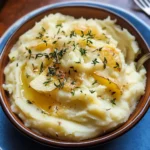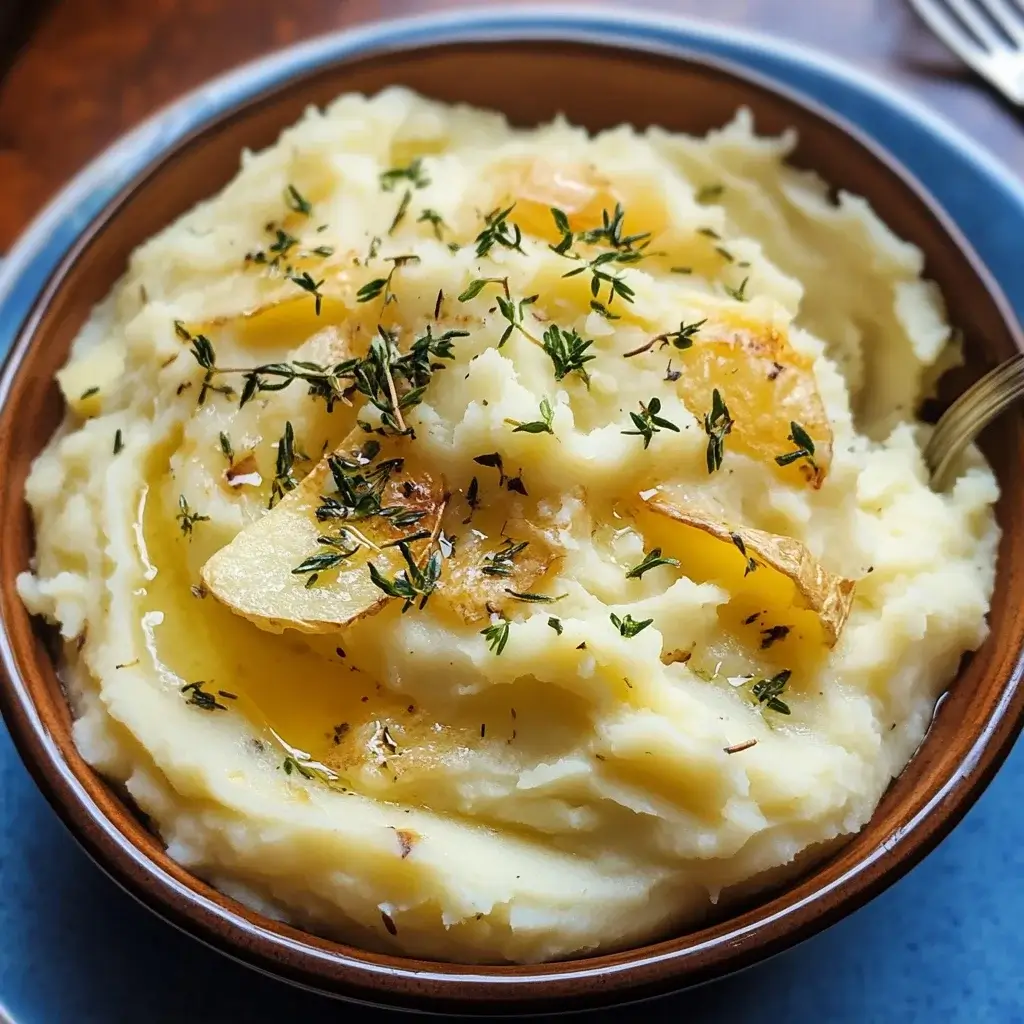After a long day, nothing quite hits the spot like a bowl of creamy, comforting mashed potatoes. In our home, mashed potatoes are more than just a side dish; they’re a staple, a warm hug on a plate. I’ve tried countless variations over the years, but this Creamy Mashed Potatoes with Herbs recipe has become a family favorite. The subtle blend of fresh herbs elevates the classic dish, adding a layer of freshness and aromatic depth that keeps everyone coming back for seconds – and sometimes thirds! Even my picky eaters, who usually shy away from anything green, devour these herby potatoes without a fuss. Whether it’s a cozy weeknight dinner or a festive holiday gathering, these mashed potatoes are always a welcome addition to the table, promising smiles and satisfied sighs with every spoonful.
Ingredients
- Potatoes: 3 lbs Yukon Gold or Russet potatoes, peeled and quartered. Yukon Golds offer a naturally creamy texture, while Russets become fluffy when mashed.
- Butter: 8 tablespoons (1 stick) unsalted butter, adding richness and flavor.
- Milk or Cream: 1 cup whole milk or heavy cream, warmed. Warm dairy ensures smooth incorporation and keeps the potatoes hot. For extra richness, use half and half or a combination.
- Fresh Herbs: 1/4 cup chopped fresh herbs like chives, parsley, rosemary, and thyme. A mix provides a complex and aromatic flavor profile. Use what you have on hand or your favorite combination.
- Garlic: 2 cloves garlic, minced (optional, but highly recommended). Garlic adds a savory depth. Roasted garlic can be used for a milder, sweeter flavor.
- Salt: 1-2 teaspoons salt, or to taste. Essential for seasoning and bringing out the flavors. Kosher salt or sea salt is preferred.
- Black Pepper: 1/2 teaspoon black pepper, freshly ground, or to taste. Adds a touch of spice and enhances the overall flavor.
Instructions
- Prepare the Potatoes: Begin by thoroughly washing the potatoes. Peel them using a vegetable peeler, ensuring all eyes and blemishes are removed. Cut the peeled potatoes into uniform chunks, about 1-2 inches in size. Consistent size is crucial for even cooking. Place the cut potatoes in a large pot.
- Boil the Potatoes: Cover the potatoes with cold water. The cold water helps the potatoes cook evenly from the inside out. Add a generous pinch of salt to the water – this seasons the potatoes as they cook, enhancing their flavor from within. Bring the water to a rolling boil over high heat. Once boiling, reduce the heat slightly to maintain a gentle boil and cook for about 15-20 minutes, or until the potatoes are fork-tender. They are ready when a fork easily pierces through the center of a potato chunk without resistance. Avoid overcooking, as this can make the potatoes waterlogged.
- Drain the Potatoes: Once the potatoes are tender, carefully drain them in a colander. Ensure you drain them thoroughly to remove excess water. Returning the drained potatoes to the still-warm pot and placing them back on the stovetop over low heat for a minute or two can help evaporate any remaining moisture, resulting in fluffier mashed potatoes. This step is often overlooked but makes a significant difference in texture.
- Mash the Potatoes: Return the drained potatoes to the pot. Now it’s time to mash them. You can use a potato ricer for the smoothest, lump-free mashed potatoes. A ricer creates light and airy potatoes. Alternatively, a potato masher works perfectly well for a slightly chunkier, more rustic texture. If using a masher, ensure you mash them thoroughly to break down any large pieces. Avoid using a food processor or blender, as these can overwork the potatoes and result in a gluey, undesirable texture due to the release of too much starch.
- Warm the Dairy and Melt Butter: While the potatoes are still warm, add the butter to the pot and let it melt into the potatoes. The residual heat will melt the butter quickly and evenly. In a separate saucepan or microwave-safe bowl, gently warm the milk or cream. Warming the dairy is crucial because adding cold milk or cream can lower the temperature of the potatoes and make them less fluffy and harder to combine smoothly. Warm dairy integrates more seamlessly, creating a creamier, more cohesive texture.
- Incorporate Dairy and Garlic: Gradually pour the warm milk or cream into the mashed potatoes while continuing to mash or stir. Add it in stages, mixing well after each addition, to control the consistency and ensure it’s incorporated evenly. If using minced garlic, add it now. For a more subtle garlic flavor, you can roast the garlic cloves beforehand and add them as roasted garlic paste. Taste and adjust the amount of milk or cream to achieve your desired level of creaminess. Some people prefer thicker mashed potatoes, while others like them looser and more fluid.
- Stir in Fresh Herbs: Once the mashed potatoes reach your desired consistency, gently stir in the chopped fresh herbs. Add them at the end to preserve their fresh flavor and vibrant green color. Stir just until the herbs are evenly distributed throughout the mashed potatoes. Avoid overmixing at this stage.
- Season and Serve: Season the mashed potatoes with salt and freshly ground black pepper to taste. Start with the recommended amounts in the ingredients list and adjust as needed. Taste and season incrementally until the flavor is perfectly balanced. Remember that seasoning is crucial – it elevates the dish from bland to delicious. Serve the Creamy Mashed Potatoes with Herbs immediately while they are hot and fluffy. Garnish with an extra sprinkle of fresh herbs on top for visual appeal and an extra burst of fresh flavor.
Nutrition Facts
(Per serving, based on 6 servings, approximate values and can vary based on specific ingredients and serving size)
- Serving Size: Approximately 1 cup
- Calories: 250-300 kcal
- Fat: 12-15g
Preparation Time
- Prep Time: 20 minutes (includes peeling and chopping potatoes, mincing garlic, and chopping herbs)
- Cook Time: 20 minutes (boiling potatoes)
- Total Time: 40 minutes (from start to finish)
This recipe is relatively quick and easy to prepare, making it a perfect choice for both weeknight meals and more elaborate dinners. The majority of the time is spent boiling the potatoes, and the active preparation steps are straightforward and efficient.
How to Serve
Creamy Mashed Potatoes with Herbs are incredibly versatile and pair well with a wide variety of dishes. Here are some serving suggestions:
- Classic Comfort Food Pairings:
- Roasted Chicken or Turkey: Mashed potatoes and poultry are a timeless combination. The creamy potatoes complement the savory roasted flavors perfectly.
- Beef or Vegetarian Meatloaf: A hearty meatloaf or vegetarian lentil loaf served alongside mashed potatoes creates a satisfying and comforting meal.
- Grilled or Pan-Seared Steak: The richness of mashed potatoes balances the savory flavor of steak, making it an ideal side.
- Sausages and Gravy: For a truly indulgent meal, serve mashed potatoes with flavorful sausages and a rich gravy.
- Holiday Feasts:
- Thanksgiving and Christmas Dinner: Mashed potatoes are a must-have side dish for holiday gatherings. They are a crowd-pleaser and complement the traditional holiday spread beautifully.
- Easter Ham or Lamb: The creamy texture and herby notes of the potatoes are a delightful accompaniment to roasted ham or lamb.
- Vegetarian and Vegan Meals:
- Mushroom Gravy: For a vegetarian option, top the mashed potatoes with a flavorful mushroom gravy.
- Roasted Vegetables: Serve alongside roasted root vegetables like carrots, parsnips, and beets for a balanced and colorful vegetarian meal.
- Lentil Stew or Curry: Mashed potatoes can be a surprising but delicious accompaniment to lentil-based stews or mild curries, adding creaminess and comfort.
- Vegetarian Sausages: Pair with plant-based sausages and a vegetarian gravy for a hearty vegetarian main course.
- Elevated Side Dish:
- With a dollop of Sour Cream or Crème Fraîche: A spoonful of sour cream or crème fraîche adds a tangy contrast to the richness of the mashed potatoes.
- Drizzled with Olive Oil and a sprinkle of Parmesan Cheese: For a Mediterranean twist, drizzle with good quality olive oil and sprinkle with grated Parmesan cheese.
- Topped with Crispy Fried Onions or Shallots: Add texture and flavor by topping with crispy fried onions or shallots.
- Served with a side of Green Beans or Asparagus: Balance the richness of the potatoes with a serving of fresh green vegetables.
Additional Tips for Perfect Creamy Mashed Potatoes
- Choose the Right Potatoes: The type of potato significantly impacts the texture. Yukon Gold potatoes are naturally creamy and require less butter and cream, while Russet potatoes become fluffy and absorb more flavor. For the creamiest results, a mix of both can be ideal. Avoid waxy potatoes like red potatoes, as they don’t mash as well and can become gummy.
- Start with Cold Water: Always start boiling potatoes in cold water. This ensures they cook evenly. If you start with hot water, the outside cooks faster than the inside, leading to unevenly cooked potatoes. Adding salt to the cold water seasons the potatoes from the inside out as they cook.
- Don’t Overcook or Undercook: Overcooked potatoes become waterlogged and can fall apart, resulting in mushy mashed potatoes. Undercooked potatoes will be lumpy and hard to mash. Cook until they are fork-tender – a fork should easily slide into the center of a potato chunk.
- Drain Thoroughly and Dry Out: After boiling, drain the potatoes very thoroughly in a colander. Returning them to the warm pot over low heat for a minute or two helps evaporate excess moisture and ensures fluffier potatoes. This step is crucial for preventing watery mashed potatoes.
- Warm Dairy is Key: Always warm your milk or cream before adding it to the mashed potatoes. Cold dairy will lower the temperature of the potatoes, making them less creamy and harder to incorporate smoothly. Warm dairy blends seamlessly and maintains the warmth of the dish.
- Don’t Overmix: Overmixing mashed potatoes, especially with a food processor or blender, can release too much starch and result in a gluey, sticky texture. Use a potato ricer or masher and mix gently until just combined. If using an electric mixer, use it on low speed and be careful not to overmix.
- Infuse Flavor with Roasted Garlic: For a deeper, sweeter garlic flavor, roast garlic cloves before adding them to the mashed potatoes. Simply roast a whole head of garlic in the oven until soft and caramelized, then squeeze out the roasted garlic paste and incorporate it into the potatoes.
- Make Ahead and Reheat Carefully: Mashed potatoes can be made ahead of time. To reheat, gently warm them in a saucepan over low heat, adding a splash of milk or cream to restore moisture and creaminess. You can also reheat them in a microwave in short intervals, stirring in between. Avoid overheating, which can dry them out. For best results, consume within 2-3 days of making.
FAQ Section
Q1: What are the best potatoes to use for creamy mashed potatoes?
A: Yukon Gold and Russet potatoes are excellent choices. Yukon Golds are naturally buttery and creamy, requiring less added fat. Russets become fluffy when mashed and absorb flavors well, resulting in light and airy mashed potatoes. A combination of both can give you the best of both worlds. Avoid waxy potatoes like red potatoes, as they don’t mash well and can become gummy.
Q2: Can I use dried herbs instead of fresh herbs?
A: Yes, you can use dried herbs if fresh herbs are not available. However, fresh herbs provide a brighter and more vibrant flavor. If using dried herbs, use about 1 teaspoon of dried herbs for every tablespoon of fresh herbs, as dried herbs are more concentrated. Add dried herbs earlier in the cooking process, such as when warming the milk, to allow their flavors to fully develop.
Q3: How can I make my mashed potatoes even creamier?
A: To make your mashed potatoes extra creamy, use heavy cream or half-and-half instead of milk. You can also increase the amount of butter. Adding cream cheese or sour cream (about 2-4 ounces) can also enhance creaminess and add a slight tang. Using a potato ricer is also key to achieving a smooth, lump-free texture, which contributes to the overall creaminess.
Q4: How do I prevent my mashed potatoes from becoming sticky or gluey?
A: Overmixing is the main culprit for sticky mashed potatoes. Avoid using a food processor or blender, as they overwork the potatoes and release too much starch. Use a potato ricer or masher and mix gently just until combined. Also, ensure you are using the right type of potatoes – waxy potatoes are more prone to becoming gluey. Draining the potatoes thoroughly and drying them out slightly in the warm pot also helps prevent excess moisture, which can contribute to stickiness.
Q5: Can I make mashed potatoes ahead of time?
A: Yes, mashed potatoes can be made ahead of time. Prepare them as directed, then store them in an airtight container in the refrigerator for up to 2-3 days. To reheat, gently warm them in a saucepan over low heat, stirring frequently and adding a splash of milk or cream to restore moisture and creaminess. You can also reheat them in the microwave in short intervals, stirring in between.
Q6: How do I reheat mashed potatoes without drying them out?
A: The key to reheating mashed potatoes without drying them out is to add moisture. When reheating in a saucepan, add a splash of milk, cream, or even broth and stir frequently over low heat until heated through. If microwaving, cover the mashed potatoes and microwave in short intervals (1-2 minutes), stirring in between each interval, and add a bit of liquid if needed. Avoid overheating, as this can dry them out.
Q7: Can I freeze mashed potatoes?
A: Yes, mashed potatoes can be frozen, although the texture may slightly change upon thawing. To freeze, let the mashed potatoes cool completely, then transfer them to freezer-safe bags or containers. For individual portions, freeze in muffin tins first, then transfer the frozen portions to a freezer bag. Thaw overnight in the refrigerator or reheat directly from frozen, adding extra liquid as needed to restore creaminess.
Q8: What can I do with leftover mashed potatoes?
A: Leftover mashed potatoes are incredibly versatile! You can use them to make potato pancakes or cakes by mixing them with an egg and some flour, then pan-frying until golden brown. They can also be used as a topping for shepherd’s pie or added to soups and stews to thicken them. Another delicious option is to use them as a filling for pierogi or potato-filled dumplings. Get creative and enjoy the leftovers in new and exciting ways!
Print
Creamy Mashed Potatoes with Herbs
Ingredients
- Potatoes: 3 lbs Yukon Gold or Russet potatoes, peeled and quartered. Yukon Golds offer a naturally creamy texture, while Russets become fluffy when mashed.
- Butter: 8 tablespoons (1 stick) unsalted butter, adding richness and flavor.
- Milk or Cream: 1 cup whole milk or heavy cream, warmed. Warm dairy ensures smooth incorporation and keeps the potatoes hot. For extra richness, use half and half or a combination.
- Fresh Herbs: 1/4 cup chopped fresh herbs like chives, parsley, rosemary, and thyme. A mix provides a complex and aromatic flavor profile. Use what you have on hand or your favorite combination.
- Garlic: 2 cloves garlic, minced (optional, but highly recommended). Garlic adds a savory depth. Roasted garlic can be used for a milder, sweeter flavor.
- Salt: 1-2 teaspoons salt, or to taste. Essential for seasoning and bringing out the flavors. Kosher salt or sea salt is preferred.
- Black Pepper: 1/2 teaspoon black pepper, freshly ground, or to taste. Adds a touch of spice and enhances the overall flavor.
Instructions
- Prepare the Potatoes: Begin by thoroughly washing the potatoes. Peel them using a vegetable peeler, ensuring all eyes and blemishes are removed. Cut the peeled potatoes into uniform chunks, about 1-2 inches in size. Consistent size is crucial for even cooking. Place the cut potatoes in a large pot.
- Boil the Potatoes: Cover the potatoes with cold water. The cold water helps the potatoes cook evenly from the inside out. Add a generous pinch of salt to the water – this seasons the potatoes as they cook, enhancing their flavor from within. Bring the water to a rolling boil over high heat. Once boiling, reduce the heat slightly to maintain a gentle boil and cook for about 15-20 minutes, or until the potatoes are fork-tender. They are ready when a fork easily pierces through the center of a potato chunk without resistance. Avoid overcooking, as this can make the potatoes waterlogged.
- Drain the Potatoes: Once the potatoes are tender, carefully drain them in a colander. Ensure you drain them thoroughly to remove excess water. Returning the drained potatoes to the still-warm pot and placing them back on the stovetop over low heat for a minute or two can help evaporate any remaining moisture, resulting in fluffier mashed potatoes. This step is often overlooked but makes a significant difference in texture.
- Mash the Potatoes: Return the drained potatoes to the pot. Now it’s time to mash them. You can use a potato ricer for the smoothest, lump-free mashed potatoes. A ricer creates light and airy potatoes. Alternatively, a potato masher works perfectly well for a slightly chunkier, more rustic texture. If using a masher, ensure you mash them thoroughly to break down any large pieces. Avoid using a food processor or blender, as these can overwork the potatoes and result in a gluey, undesirable texture due to the release of too much starch.
- Warm the Dairy and Melt Butter: While the potatoes are still warm, add the butter to the pot and let it melt into the potatoes. The residual heat will melt the butter quickly and evenly. In a separate saucepan or microwave-safe bowl, gently warm the milk or cream. Warming the dairy is crucial because adding cold milk or cream can lower the temperature of the potatoes and make them less fluffy and harder to combine smoothly. Warm dairy integrates more seamlessly, creating a creamier, more cohesive texture.
- Incorporate Dairy and Garlic: Gradually pour the warm milk or cream into the mashed potatoes while continuing to mash or stir. Add it in stages, mixing well after each addition, to control the consistency and ensure it’s incorporated evenly. If using minced garlic, add it now. For a more subtle garlic flavor, you can roast the garlic cloves beforehand and add them as roasted garlic paste. Taste and adjust the amount of milk or cream to achieve your desired level of creaminess. Some people prefer thicker mashed potatoes, while others like them looser and more fluid.
- Stir in Fresh Herbs: Once the mashed potatoes reach your desired consistency, gently stir in the chopped fresh herbs. Add them at the end to preserve their fresh flavor and vibrant green color. Stir just until the herbs are evenly distributed throughout the mashed potatoes. Avoid overmixing at this stage.
- Season and Serve: Season the mashed potatoes with salt and freshly ground black pepper to taste. Start with the recommended amounts in the ingredients list and adjust as needed. Taste and season incrementally until the flavor is perfectly balanced. Remember that seasoning is crucial – it elevates the dish from bland to delicious. Serve the Creamy Mashed Potatoes with Herbs immediately while they are hot and fluffy. Garnish with an extra sprinkle of fresh herbs on top for visual appeal and an extra burst of fresh flavor.
Nutrition
- Serving Size: one normal portion
- Calories: 300
- Fat: 15g



